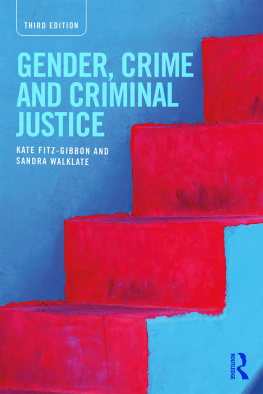Second Edition
DOING JUSTICE,
DOING GENDER
Susan Martin dedicates this book to her late mother, Harriette Ehrlich,
and to her grandchildren, Jacob, Rose, Oliver, and Nicole.
Nancy Jurik dedicates this book to her mother, Carolyn Nekuza Jurik.
Second Edition
DOING JUSTICE, DOING GENDER
Women in Legal
and
Criminal Justice
Occupations
Susan Ehrlich Martin
Chevy Chase, Maryland
Nancy C. Jurik
Arizona State University
Copyright 2007 by Sage Publications, Inc.
All rights reserved. No part of this book may be reproduced or utilized in any form or by any means, electronic or mechanical, including photocopying, recording, or by any information storage and retrieval system, without permission in writing from the publisher.
For information:
| Sage Publications, Inc.
2455 Teller Road
Thousand Oaks, California 91320
E-mail: |
Sage Publications Ltd.
1 Olivers Yard
55 City Road
London EC1Y 1SP
United Kingdom |
Sage Publications India Pvt. Ltd.
B-42, Panchsheel Enclave
Post Box 4109
New Delhi 110 017 India |
Printed in the United States of America
Library of Congress Cataloging-in-Publication Data
Martin, Susan Ehrlich.
Doing justice, doing gender : women in legal and criminal justice occupations / Susan Ehrlich Martin, Nancy C. Jurik.2nd ed.
p. cm.
Includes bibliographical references and index.
ISBN 1-4129-2720-X or 978-1-4129-2720-8 (cloth)ISBN 1-4129-2721-8 or 978-1-4129-2721-5 (pbk.)
1. Sex discrimination in criminal justice administrationUnited States. 2. PolicewomenUnited States. 3. Women correctional personnelUnited States. 4. Women lawyersUnited States. I. Jurik, Nancy C. II. Title.
HV9950.M3 2007
364.973082dc22 2006015203
This book is printed on acid-free paper.
06 07 08 09 10 10 9 8 7 6 5 4 3 2 1
Acquisitions Editor: | Jerry Westby |
Editorial Assistant: | Kim Suarez |
Production Editor: | Laureen A. Shea |
Copy Editor: | Jennifer Withers |
Typesetter: | C&M Digitals (P) Ltd. |
Proofreader: | Kevin Gleason |
Indexer: | Will Ragsdale |
Cover Designer: | Candice Harman |
Contents
List of Tables
Acknowledgments
T his revised version of Doing Justice, Doing Gender is the outcome of the equal collaboration of the authors who undertook this revision at the urging of Sage editor Jerry Westby. Our goal, as in the initial version, is to produce a readable but thorough and theoretically grounded examination of the changes that have occurred in the criminal justice organizations, occupations, and womens work in them both over the past 40 years and, in this edition, in the past decade. As our readers will discover, there is both good news and bad news. The numbers of women in policing, legal careers, and corrections work have grown, and more women are moving up the career ladder to become supervisors and partners in law firms. Nevertheless, discrimination and informal barriers to womens achievements in these occupations continue. In this edition, we have maintained our theoretical perspective and the organizational structure of the earlier book. We have updated the material by discussing new trends in each of the occupations and how these affect women, and we have included new research findings and statistical material. In addition, given growing globalization and the presence of women in justice occupations worldwide, we have included some materials on women in each occupation from an international perspective.
We wish to thank the six Sage reviewers whose comments helped guide our revision: Polly F. Radosh, Phoebe Morgan, Becky L. Tatum, Rebecca S. Katz, Jessie Krienert, and Lori Elis. We also wish to thank Belinda Herrera for help with the references and comments on
CHAPTER 1
Introduction
Changes in Criminal Justice,
Occupations, and Women in the Workplace
B efore 1972, the number of women employed in the justice system as police officers, lawyers, judges, and correctional officers (COs) was minuscule; those women were excluded from most jobs that entailed the exercise of authority over men. Women worked only as specialists, drawing on qualities and skills associated with their gender. For example, policewomen supervised women and juvenile arrestees and performed secretarial work. Women lawyers were concentrated in specialties deemed appropriate for women, such as domestic relations; they rarely litigated cases or became judges. Women COs worked in prisons for women or in juvenile institutions where their capacity for mothering was considered beneficial for rehabilitating delinquent youth.
As part of a larger societal trend, women have entered the workplace in increasing numbers and moved into occupations traditionally filled by men only. Since the late 1970s, a growing number of women work in all parts of the justice system. In the criminal justice system (CJS), police agencies hire women as patrol officers, and probation and parole departments assign mixed-gender caseloads to women. Local jails, state correctional systems, and the Federal Bureau of Prisons hire women to guard men inmates. Women lawyers handle civil and criminal cases as private or governmental attorneys and serve as judges and magistrates. Women also comprise a growing proportion of the professors in law schools and departments of criminal justice, criminology, and sociology, where they educate the next generation of CJS personnel. Women are also advancing in justice fields; more women have been promoted and hold visible leadership positions. To some extent, the presence of women in these realms is now taken for granted.
Despite these inroads, individual and organizational resistance to women in justice fields continues, and women are often still treated as second-class citizens in the station house, courtroom, and prison. The obstacles faced by women justice workers are part of organizational and societal arrangements that construct and reinforce womens subordination to men. Women in fields numerically dominated by men face many barriers: exclusion from informal work cultures; hostility expressed in social interactions; organizational policies that permit gender segregation, differential assignments, sexual harassment; and the marginalization of women with family responsibilities. The confluence of these barriers often produces fewer recruits, lower pay, slower advancement, and in some cases, higher dropout rates for the women in these fields.
Resistance to women may be associated with the social control functions of justice occupations. Criminologist Frances Heidensohn (1992, p. 99) has argued that social control is a profoundly gender-linked concept. Women have always helped to maintain social order, initially only informally in the family. Later, women were given institutional authority over children and other women but had to operate within control systems dominated by men; they rarely were granted formal authority over men.







